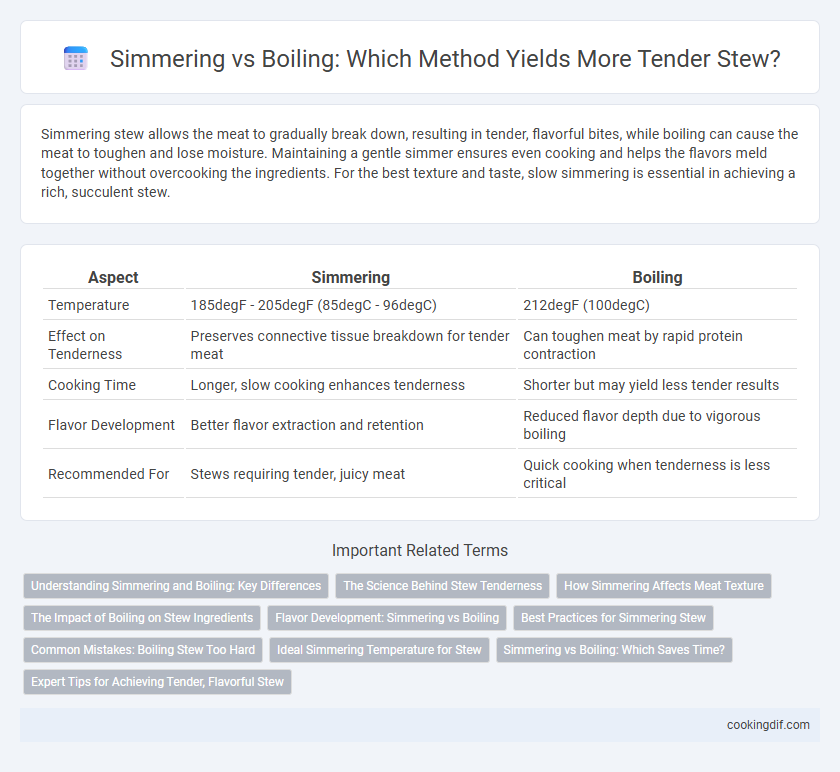Simmering stew allows the meat to gradually break down, resulting in tender, flavorful bites, while boiling can cause the meat to toughen and lose moisture. Maintaining a gentle simmer ensures even cooking and helps the flavors meld together without overcooking the ingredients. For the best texture and taste, slow simmering is essential in achieving a rich, succulent stew.
Table of Comparison
| Aspect | Simmering | Boiling |
|---|---|---|
| Temperature | 185degF - 205degF (85degC - 96degC) | 212degF (100degC) |
| Effect on Tenderness | Preserves connective tissue breakdown for tender meat | Can toughen meat by rapid protein contraction |
| Cooking Time | Longer, slow cooking enhances tenderness | Shorter but may yield less tender results |
| Flavor Development | Better flavor extraction and retention | Reduced flavor depth due to vigorous boiling |
| Recommended For | Stews requiring tender, juicy meat | Quick cooking when tenderness is less critical |
Understanding Simmering and Boiling: Key Differences
Simmering maintains a gentle heat just below boiling point, around 185degF to 205degF (85degC to 96degC), which allows tough meat fibers in stew to slowly break down, resulting in tender, flavorful meat. Boiling occurs at 212degF (100degC), causing vigorous bubbles that can toughen the meat by contracting proteins too quickly and can make the stew cloudy. Understanding these temperature differences is crucial for achieving the ideal stew tenderness and clarity.
The Science Behind Stew Tenderness
Simmering stew at a temperature just below boiling, around 185-205degF (85-96degC), allows collagen in tough meat cuts to break down into gelatin, enhancing tenderness and mouthfeel. Boiling at 212degF (100degC) can cause proteins to contract too quickly, resulting in tougher meat fibers and a less desirable texture. The controlled, gentle heat of simmering ensures even cooking and optimal extraction of flavors, making it the preferred method for achieving tender, flavorful stew.
How Simmering Affects Meat Texture
Simmering stew allows collagen in tougher cuts of meat to break down slowly, resulting in a tender and juicy texture. The gentle heat prevents the meat fibers from contracting harshly, preserving moisture and enhancing flavor absorption. Maintaining a consistent simmer ensures even cooking, producing a rich, melt-in-your-mouth stew texture compared to the toughness caused by vigorous boiling.
The Impact of Boiling on Stew Ingredients
Boiling stew causes rapid, high-temperature agitation that can break down proteins and vegetables too quickly, resulting in tougher meat and mushy vegetables. Simmering maintains a gentle, consistent heat that allows collagen in tougher cuts to slowly convert into gelatin, enhancing the tenderness and richness of the stew. The impact of boiling often leads to uneven cooking and loss of flavor concentration, while simmering preserves the stew's texture and depth.
Flavor Development: Simmering vs Boiling
Simmering stew allows flavors to meld gradually, enhancing depth and richness by preventing the breakdown of delicate ingredients. Boiling, with its higher temperature, risks toughening meat and causing flavors to become harsh or overly concentrated. Maintaining a gentle simmer optimizes both tenderness and flavor complexity in stew preparation.
Best Practices for Simmering Stew
Simmering stew at a low, consistent temperature between 185degF and 205degF ensures tough meat fibers break down slowly, resulting in tender, flavorful dishes. Avoid boiling, which occurs at 212degF, as it causes proteins to contract rapidly, making the meat tough and broth cloudy. Maintain a gentle simmer by adjusting the heat and covering the pot partially to preserve moisture and promote even cooking.
Common Mistakes: Boiling Stew Too Hard
Boiling stew too hard often leads to tough, dry meat instead of tender, juicy bites, as excessive heat causes proteins to contract and squeeze out moisture. Simmering at a low, steady temperature between 185degF and 205degF allows collagen to break down slowly, yielding a melt-in-your-mouth texture. Avoid rapid boiling; maintaining gentle heat preserves the stew's rich flavors and ensures optimal tenderness.
Ideal Simmering Temperature for Stew
Ideal simmering temperature for stew ranges between 185degF to 205degF (85degC to 96degC), allowing collagen in tougher meat cuts to break down gradually for enhanced tenderness. Maintaining a consistent simmer rather than boiling prevents meat fibers from contracting excessively, resulting in a juicier, more flavorful stew. This controlled low heat also ensures vegetables cook evenly without becoming mushy, preserving the dish's rich texture.
Simmering vs Boiling: Which Saves Time?
Simmering stew typically preserves tenderness better than boiling, as boiling's high temperature can toughen meat fibers and cause vegetables to break down excessively. Simmering gently cooks ingredients at around 185-205degF (85-96degC), which takes more time but enhances flavor and texture. Boiling at 212degF (100degC) may speed up cooking but often sacrifices the desired tenderness and depth of stew.
Expert Tips for Achieving Tender, Flavorful Stew
Simmering stew at a low, consistent temperature between 185degF and 205degF allows tough meat fibers to break down gradually, resulting in tender, juicy pieces that retain their flavor. Boiling can cause the meat to toughen and the broth to become cloudy due to rapid agitation, which disrupts the collagen conversion essential for richness. Expert chefs recommend maintaining a gentle simmer and using a heavy-bottomed pot to evenly distribute heat and create a deeply flavorful stew.
Simmering vs boiling for stew tenderness Infographic

 cookingdif.com
cookingdif.com